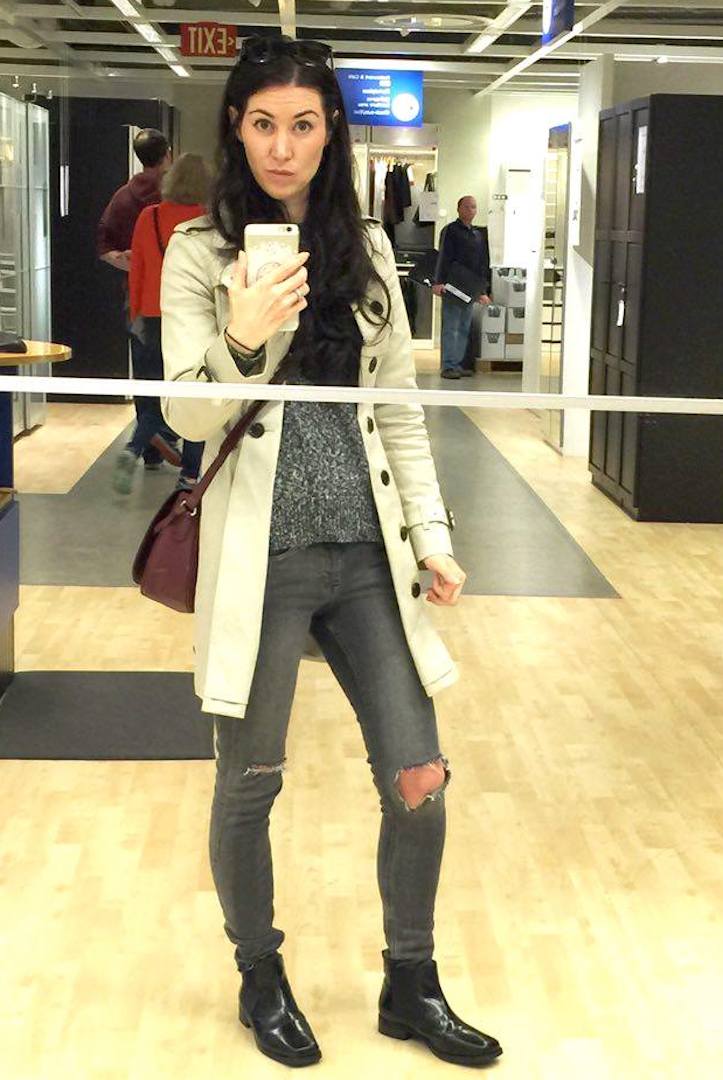Eco Burn Out

[apss-share]
A bad case of eco burn out
Just over a week ago I did something that if you had asked me the day or even the hour before I would have said “never would I ever!” But I’ll get to that in just a bit.
Originally I had planned on writing an article about why eco fashion is so confusing. The more I worked on it, the more I lost interest in writing about it. What is eco? What is sustainable? What is green? What is ethical? What is slow? What is capsule? What is fair trade? What is living wage?… I could go on for a few more lines but I’ll spare you. In the end the article never got finished, mostly due to the fact that I was sick of talking about it and I’m pretty sure you are sick of hearing about it. *If you aren’t I know I will be coming back to it in the future, so stayed tuned* It was only after reflecting on an article written by the absolutely on point Leah Wise of Style Wise Blog (Article Here, definitely give it a read!) that I realized I was suffering from, what I will call, Eco Burn Out.
“…I didn’t want to talk to anybody about what I was wearing or explain the nuanced principles of eco fashion…I should have seen eco burn out coming”
Signs of Eco Burn Out
In retrospect I probably should have seen it coming. Blogging has slowed down, I didn’t enjoy looking at some of favorite companies anymore, I didn’t want to talk to anybody about what I was wearing or explain the nuanced principles of eco fashion, lost interest in social media, I wasn’t enjoying getting dressed as I felt uninspired by a lot of my clothing, and to top it off my husband said I was acting like a crazy person (to his credit I absolutely was). One night while scrambling my brain to come up with new blog topics I couldn’t sleep and finally got out of bed at 3am to make blueberry muffins. Baking has always been a stress reliever for me. Unfortunately for my husband, I managed to eat almost all of them. (Life happens). He suggested I take time out and reflect about moving forward with WTT. If it was driving me this crazy was it really worth continuing?
“But, I couldn’t help but feel a little guilty. What had I done?”
Act of Rebellion
This brings me to my mistake, no I won’t call it that. I’ll let you decide what it was. I decided to go to the mall (shockingly I haven’t step foot in one in over a year and a half). The goal was to see if I could find some eco labels at some of my former favorite stores including Nordstrom. I knew they carried them online but in stores? Had to see for myself. Well, not surprisingly I didn’t find much of a selection (not to say that there isn’t any) but in the midst of my searching I found a sweater and skirt that called out to me. The problem: they weren’t eco, at least not in the traditional sense. But hey, I thought, if I’m going to stop blogging about eco fashion what’s the harm of trying them on? So I did. Which ended up with me purchasing them… (insert your judgements here) The sweater was made 100% of bio degradable fabric and the skirt was something I could mix and match different ways. Meaning it has closet staying potential and won’t be a seasonal discard. But, I couldn’t help but feel a little guilty. What had I done? Were they made in living wage factories? Were the farmers who produced the fibers paid fairly? Were the synthetic materials made from recyclables? Did they use non-toxic dyes?
“I could stop blogging at any point, give up eco fashion, and move on with my life.”
The Problem
The biggest hurdle I faced after purchasing these two items wasn’t that I didn’t know their true eco identities, although I’ll talk about this in just a couple lines down but, that I felt good. No, not good, great! My husband said when I was trying them on I was smiling like he hasn’t seen in years. It was the style, the fit, the color, the ease in which I felt I could find something that fit my style profile, and maybe possibly the fact that I was never a fan of online shopping (which is where most eco purchases happen). I felt a sense of control again over my closet and myself. So why was I putting myself through all this stress? I could stop blogging at any point, give up eco fashion, and move on with my life. The problem lies in the fact that I was drawn to eco fashion out of principle. I love what the industry stands for and that I, as a consumer, have the power of choice to make a difference. My voice counts and could potentially sway an entire industry. I want people to work in jobs that they are paid justly for and provides them security. I want to end water, air and soil contamination. I don’t want our clothing flooding other countries markets and killing their local economies. I don’t want to harm animals. I want to support women in the workplace. But most importantly, I want to be happy. To do that I had to get to the root of my eco burn out.
“In my quest to be an ethical purist I was ignoring what made me happy about fashion in the first place, the styles.”
When I saw Leah’s article “Why I quit being an ethical purist” a couple of days after my purchase it hit me like a ton of bricks. I was trying to be everything at once resulting in some serious eco burn out. She succinctly pointed out the reason I was feeling the way I was, trying to promote the entire eco industry at once. When I made the switch from high end fashion to eco fashion I did so because human rights have always been a focus in my life. And it seemed like a natural fit to bridge fashion and fair working conditions. But, this soon turned into fair trade, and then pollution, and then recycling, and then second hand, and then veganism. Now, before you say anything, I fully applaud and support the people out there who are able to conquer all of these topics with their wardrobe. I however, have discovered I am not one of them. In my quest to be an ethical purist I was ignoring what made me happy about fashion in the first place, the styles. Instead of wearing pieces I loved I was buying pieces that fit an agenda which in turn made me miserable. And, if I didn’t want to talk about it and didn’t feel great wearing it, what was the point?
“I am a full supporter of eco fashion in all its facets but I don’t think I can do it all and am doing a great disservice to myself and to the industries tenets by pretending I can.”
Thank you Leah
Here’s the thing: I don’t want to stop blogging. And, if I hadn’t have seen Leah’s article I would still be suffering from eco burn out. Her post made me realize I didn’t need to stop. I just needed to adjust my priorities. I am a full supporter of eco fashion in all its facets but I don’t think I can do it all and am doing a great disservice to myself and to the industries tenets by pretending I can. I wear dresses I bought years ago from fast fashion retailers. Try explaining eco fashion to someone when they ask you where you clothing came from and you answer (insert any fast fashion retailer here). Seems like it undermines your point, doesn’t it? But, here’s what I have come to realize. I love my clothing. Each one of them is bought with purpose. Not a one-time wear. I’m at ease with my recent purchases from the mall knowing I will wear them for years to come but also now know that my focus lies in factories, not the environment, not ethical fashion, and not the materials. That is not to say these aren’t important but for me they take a backseat to factories and living wages. I have long been a preacher of buy what you love, love what you wear, and treat it as if it was your only garment for the next 10 years. I’m not a capsule blogger because my style doesn’t allow me to be. I am okay with this.
“Even a single step forward is progress: progress towards a cleaner, more ethical, more sustainable landscape.”
Lessons Learned
Shop with a purpose. For me that means looking at who made my clothes and evaluating if a garment brings me joy or not. I want to feel that each time I get dressed it’s something special. That each garment is a celebration unto itself, in essence I will love it for years to come. Does it bring purpose to my life or am I just filling a void? In the end be you and don’t try to be it all. If you can, great! Let me know your secret. Find what speaks the loudest to you. What’s the cause you want to take up? Believe it or not you don’t have to take it all on to make a difference. The fashion industry is already starting to change thanks to you. They are seeing that consumers want more green/eco/ethical/sustainable options. But, just like we all don’t gravitate towards the same top, we all aren’t going to gravitate towards the same cause. And, that’s okay. If animals are you’re thing pursue vegan fashion. If pollution is your concern pursue nontoxic fabrics. If reducing waste is your thing pursue a capsule collection or second hand. Don’t feel bad for you. And, if I’ve learned any lessons from my eco burn out it’s that you don’t have to excuse or explain yourself to anyone. Even a single step forward is progress: progress towards a cleaner, more ethical, more sustainable landscape.




